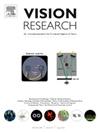聚光异常与弱视的立体视觉受损有关。
IF 1.4
4区 心理学
Q4 NEUROSCIENCES
引用次数: 0
摘要
我们检查了在弱视组和立体正常对照组中立体视觉和融合收敛之间的关系。由于绝对视差被认为是相对视差和视差驱动辐散的基础,我们假设辐散异常会伴随着立体视觉受损。具体来说,我们研究了视野中央20°的立体视觉受损模式是否伴随着局限于这些区域的刺激的融合辐散受损。立体视在视野范围内局部测量,视差步距为5 ~ 20角分。双目眼动跟踪测量大视差步长(2 ~ 3°)的融合收敛度。辐合刺激为随机点立体图,具有3种空间构型:直径为16°的大圆盘、直径为4°的小圆盘和大小圆盘对应的外径和内径的环。在没有视觉发育异常史的对照组(n = 25)中,12个人在整个视野中表现出正常的立体视觉,并且在所有配置下都表现出正常的聚光增益。13名中央区立体视功能弱的个体,在小刺激下呈现异常收敛,而在大刺激下呈现正常收敛。弱视/斜视个体(n = 12)立体视觉较差,对小刺激的收敛性较差。我们报告了散度,粗立体和细立体之间的强相关性,没有双重解离(没有与正常立体受损的散度)。综上所述,结果表明双目相互作用受损是立体视觉和聚光缺陷的原因。本文章由计算机程序翻译,如有差异,请以英文原文为准。
Vergence anomalies are associated with impaired stereopsis in amblyopia
We examined the relationship between stereopsis and fusional vergence in groups of amblyopic and stereo-normal control observers. As absolute disparity is thought to be the basis for relative disparity and for disparity-driven vergence, we hypothesized that vergence anomalies would be accompanied by impaired stereopsis. Specifically, we examined whether patterns of impaired stereopsis across the central 20° of the visual field were accompanied by impaired fusional vergence for stimuli confined to these regions. Stereopsis was measured locally across the visual field with disparity steps of 5 to 20 arcmin. Fusional vergence to large disparity steps (2 to 3°) was measured with binocular eye tracking. The vergence stimuli were random dot stereograms, in one of 3 spatial configurations: a large disc 16° in diameter, a small disc 4° in diameter, and an annulus with outer and inner diameters corresponding to the large and small discs. Of the controls (n = 25) with no history of abnormal visual development, 12 individuals exhibited normal stereopsis across the visual field and normal vergence gains for all configurations. Thirteen individuals with weak stereopsis in the central field tended to have anomalous vergence for small stimuli, but normal vergence for larger stimuli. Amblyopic/strabismic individuals (n = 12) had poor stereopsis and poor vergence for small stimuli. We report a strong correlation between vergence, coarse and fine stereopsis, with no double dissociation (no cases of impaired vergence with normal stereopsis). Taken together, the results suggest that compromised binocular interaction is the cause of both stereopsis and vergence deficits.
求助全文
通过发布文献求助,成功后即可免费获取论文全文。
去求助
来源期刊

Vision Research
医学-神经科学
CiteScore
3.70
自引率
16.70%
发文量
111
审稿时长
66 days
期刊介绍:
Vision Research is a journal devoted to the functional aspects of human, vertebrate and invertebrate vision and publishes experimental and observational studies, reviews, and theoretical and computational analyses. Vision Research also publishes clinical studies relevant to normal visual function and basic research relevant to visual dysfunction or its clinical investigation. Functional aspects of vision is interpreted broadly, ranging from molecular and cellular function to perception and behavior. Detailed descriptions are encouraged but enough introductory background should be included for non-specialists. Theoretical and computational papers should give a sense of order to the facts or point to new verifiable observations. Papers dealing with questions in the history of vision science should stress the development of ideas in the field.
 求助内容:
求助内容: 应助结果提醒方式:
应助结果提醒方式:


